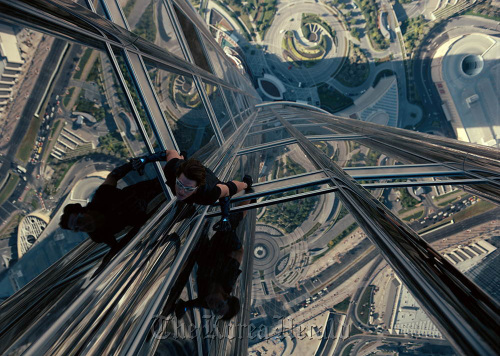
Tom Cruise plays Ethan Hunt in “Mission: Impossible ― Ghost Protocol,” from Paramount Pictures and Skydance Productions. (MCT)
With the success of “Mission: Impossible ― Ghost Protocol” comes the industry realization, or rather the industry press speculation, that Tom Cruise is back, baby, back as a bankable movie star.
As someone not in the same profession as Cruise, and who is only a year older than he but who looks about 49 years older, I find this sort of sweet. (And it’s true, probably.) Movie stars today aren’t allowed the luxury of a few forgettable films, not when they cost what “Knight and Day” did. For the record that one was a little less than forgettable. Amazing teeth and high-velocity sprinting, in the direction opposite a computer-generated fireball, cannot compensate for a script that is all hole and no doughnut.
While we’re on the subject of running ... this I find fascinating about Cruise. His global persona rests not on gracefully aging authority, but on eternally youthful, even manic intensity. It comes out in the running most of all.
Many have noted that crazed look in Cruise’s eyes when he’s at top speed on two legs. It’s faintly comic ― yet by now, it has become a part of why we respond to Cruise as a franchise action hero. He’s an actor too, it should be noted, having been tested most rewardingly in Paul Thomas Anderson’s “Magnolia” as the hollow self-help guru. He is not, however, an actor who seems to be turning 50 this summer. Cruise is our super-cranked Peter Pan. How the hell can he be turning 50?
Now: Compare Cruise to George Clooney, who is only 14 months older than Cruise, yet who seems like a generation apart.
Clooney has done his share of running, killing and action-heroing on screen. But he has been careful, from the beginning of his bankability, to thwart audience expectations. Like Cruise in “Jerry Maguire,” neatly meeting the demands of one of his most pleasing showcase roles, Clooney in “The Descendants” is working in a zone of extreme and artful comfort. Because the script is a fine and supple comedy-drama, the comfort zone allows Clooney to concentrate on how he interacts, generously and subtly, with everybody else. And when Clooney runs down the street in “The Descendants,” it’s deliberately funny, in a way Cruise likely would have a hard time replicating.
We build these people up only to tear them down to build them up again. That’s how Cruise must feel: How many “He’s up! He’s down!” gossip news cycles can one middle-aged movie star endure? Now that he’s up again, I hope Cruise takes full advantage.
I hope he does what Brad Pitt has done. In Pitt we have a movie star who has taken comfortable but not traditionally bankable roles, such as Billy Beane in “Moneyball,” and because he’s working with directors as sharp as that terrific film’s Bennett Miller, he has had opportunities to become a more specific and interesting actor.
In Terrence Malick’s “The Tree of Life,” Pitt dug deeply and came up with a complex portrait of disappointed, rageful fatherhood, largely without dialogue. It was a risk. A lot of people detest that picture. But Malick’s mosaiclike approach to storytelling forced Pitt to become a more honest and intuitive performer.
Movie stars are dying out, some say. Well. There’s no more studio system, true. And $20 million paychecks are harder to secure these days. Isn’t that a miserable, crying shame?
But among other reasons, we go to the movies to enjoy the faces and bodies on screen, at rest and in motion. The best screen performers know how to remain bankable. The lucky ones, the smart ones, become real actors when they forget what they know about bankability.
By Michael Phillips
(Chicago Tribune)
(MCT Information Services)






